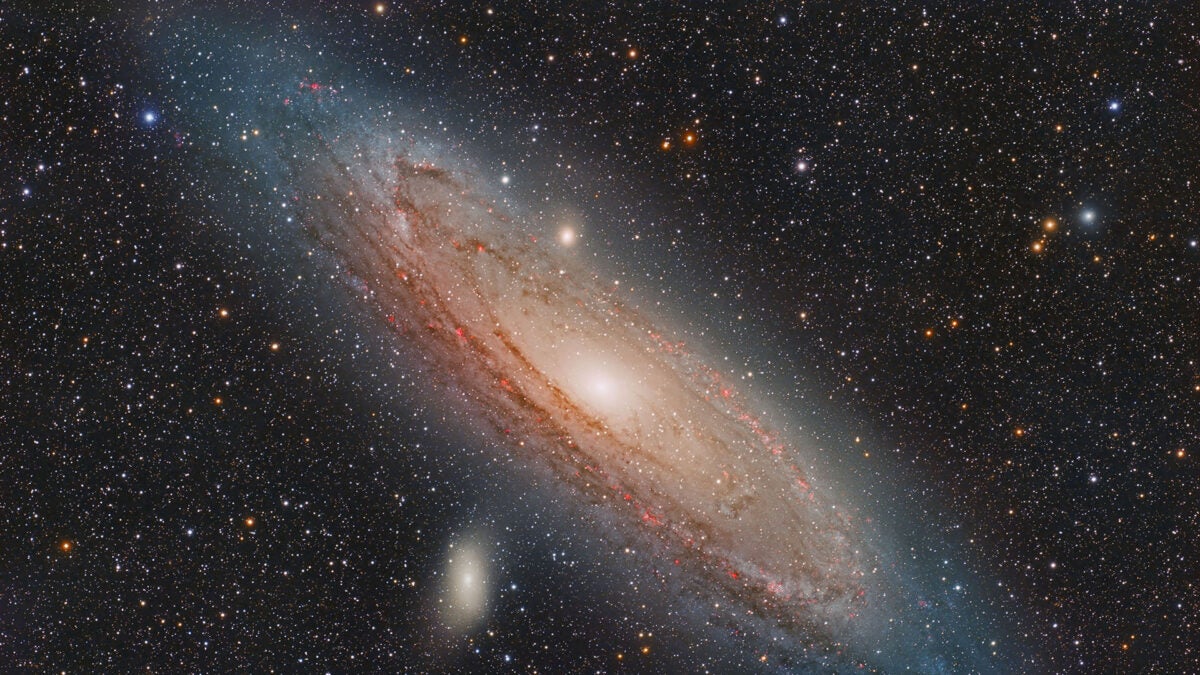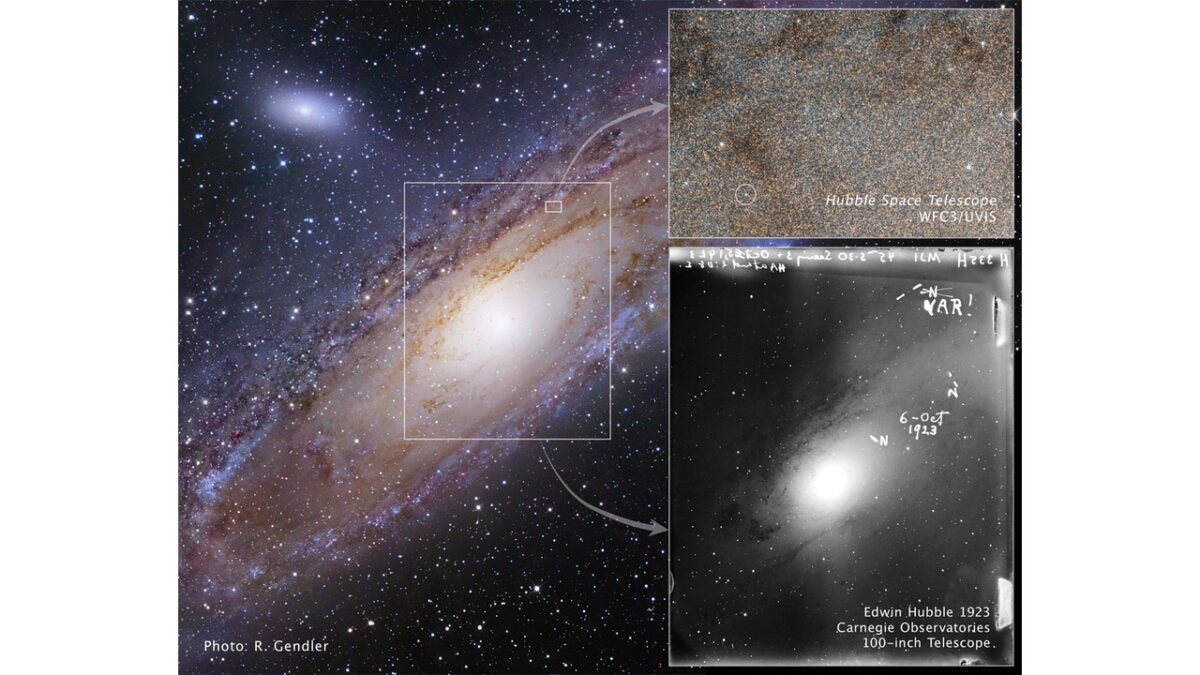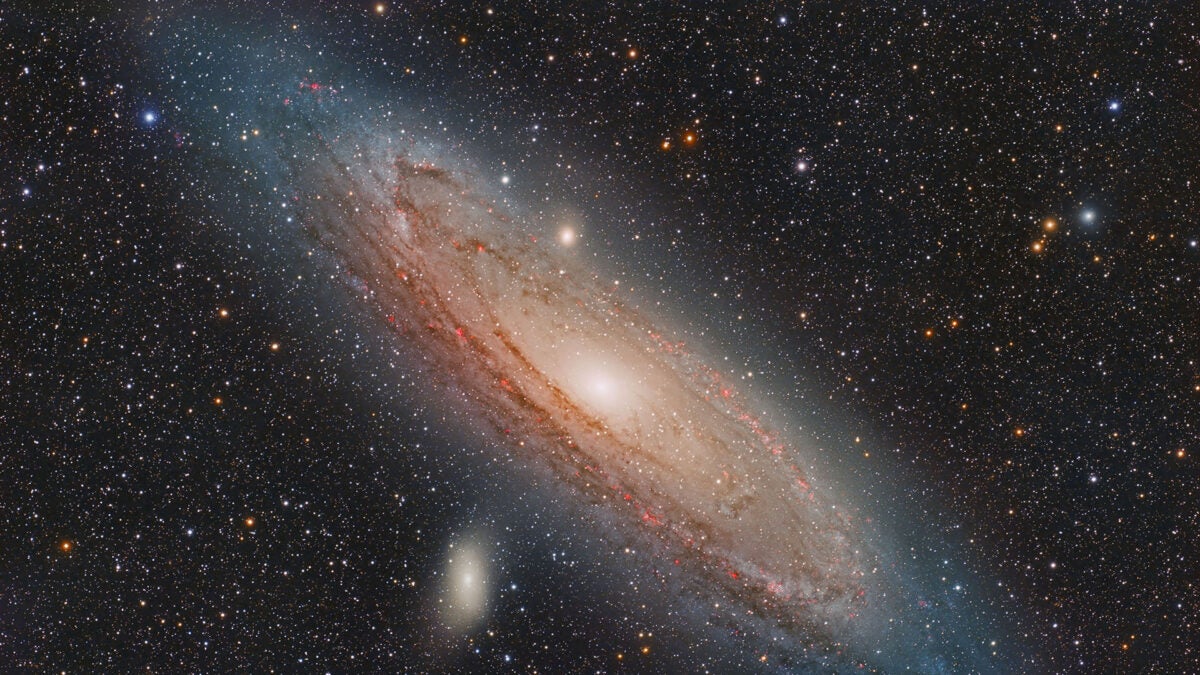
This image shows the beautiful Andromeda Galaxy with its two smaller companion galaxies. Credit: Terry Hancock
By the dawn of the 20th century, not much had changed in the 400 years since Galileo’s discovery of the four jovian moons and his confirmation of Copernicus’ Sun-centered solar system.
Through the early 1900s, astronomers disagreed on whether the universe was home to a multitude of galaxies, so-called “island universes,” or contained entirely within the boundaries of the Milky Way Galaxy. To that point no one had yet come up with evidence proving one side or the other.
Leavitt’s special stars
In 1912, Harvard College Observatory Director Edward Pickering published a report by a little-known assistant named Henrietta Swan Leavitt in the observatory’s circular. The paper, titled “Periods of 25 Variable Stars in the Small Magellanic Cloud,” was destined to change the course of our understanding of the universe.
Leavitt had uncovered a unique characteristic of Cepheid variable stars, a type of pulsating star with a dependable relationship between brightness and the length of its period (from dimmest to brightest). The brighter the star, the slower it blinked.
This was an important discovery. It meant that a formula could be created linking the period-luminosity relation of these stars to their distance. In short, astronomers could begin to measure the cosmos.
Related: Meet Henrietta Leavitt, the woman who gave us a universal ruler
A year later astronomers Ejnar Hertzsprung and Henry Norris Russell independently demonstrated how Cepheids, named after the prototype, Delta (δ) Cephei, could be deployed to determine relative distances in space using the Sun’s orbit as a baseline.
Harlow Shapley updates Copernicus
Meanwhile, in 1914, astronomer Harlow Shapley began his career at Mount Wilson Observatory near Los Angeles. Shapley’s interest was in the study of the Milky Way, and he began to use Cepheid variables in the then 69 known globular clusters (vast, gravitationally bound concentrations of stars) to calculate the clusters’ sizes and shapes using the 60-inch reflecting telescope.
In an historic series of papers culminating in 1918, Shapley capitalized on the work of Leavitt and Hertzsprung to conclude the Milky Way was 300,000 light-years in diameter. Its shape, he calculated, was disklike and the solar system was some 50,000 light-years from its center.
It was an ingenious mode of attack (and one Hubble would employ to make his breakthrough discovery a few years later). In one of the great research expeditions in modern cosmology, Shapley had updated both Copernicus and Galileo. But, although Shapley was convinced his new universe was all there was, others remained skeptical.
The “Great Debate” of 1920
In 1920 a debate took place between Harlow Shapley and Heber Curtis, a leading advocate of the island universe theory and the newly appointed director of the Allegheny Observatory at the University of Pittsburgh.
The debate was held on April 26 at the Smithsonian Institution in Washington, D.C. Curtis, 48, argued on behalf of island universes, and Shapley, 34, essentially on his own behalf.
Curtis’ galaxy was just 10,000 light-years across, a tenth of its actual size. It was also bun-shaped, with the Sun at its center. On the other hand, Shapley’s galaxy was three times too large in scale and, although his idea was correct that the solar system is located far from its center, he placed it at twice its actual distance. Shapley’s assertion of the galaxy’s disklike shape was more accurate than that of Curtis.
Despite what looks in hindsight to be a Shapley victory, the result of the debate to those present was essentially a draw. The answer to the question as to the nature of the nebulae was still in doubt.
Enter Edwin Hubble.

Illustration: NASA, ESA, and Z. Levay (STScI)
Hubble and the Hooker 100-inch Telescope
Hubble arrived at Mount Wilson in the fall of 1919, just as the Hooker 100-inch telescope was coming online. His timing couldn’t have been better. He had been studying so-called spiral nebulae for years and now he had access to the largest and most technologically advanced telescope in the world, one he could use to study his targets in greater detail.
Fast forward to four years later, October 5/6, 1923. Hubble was reviewing plates he’d taken of Andromeda (M31) with the 100-inch reflector on a routine search for novae (exploding stars) when he noticed the telltale signature of what appeared to be a Cepheid variable. Comparing the star’s brightness on previously made plates, he soon confirmed it was in fact a Cepheid. Unable to control his excitement, Hubble wrote on the back of the plate in red wax pen, “Var!”
Over the course of the next month, Hubble continued to study this star and, using Shapley’s system of measurement, he calculated the distance to M31 as 930,000 light-years from Earth. Although this is less than half the actual distance to Andromeda, it was more than three times greater than Shapley’s entire universe.
Related: The star that changed the cosmos: M31-V1
Edwin Hubble had gathered the first proof that galaxies are distant, huge clouds of stars and gas and dust. Throughout the coming months, he discovered more Cepheids in M31 and its nearby companion M33 and measured their distances to confirm they were both galaxies far from the Milky Way.
Hubble let the discovery leak to The New York Times on November 22, 1924, and his formal report was read aloud by Henry Norris Russell at a joint conference of the American Association for the Advancement of Science (AAAS) and the American Astronomical Society (AAS) on January 1, 1925.
This act of cosmic archaeology would prove to be the purest, most objective discovery of Hubble’s career. As Carnegie Observatories Director John Mulchaey put it to me recently: “It’s really challenging to underscore just how significant Hubble’s discovery of external galaxies was to astronomy. He instantaneously changed our view of the universe. In my mind, this discovery is the most significant in all of astronomy in the last 400 years, dating back to the work of Copernicus and Galileo. Simply put, Hubble’s work is responsible for establishing our modern view of the universe. Everything we study today is based on his work.”
After 400 years of uncertainty, Edwin Hubble had won the Great Debate.



